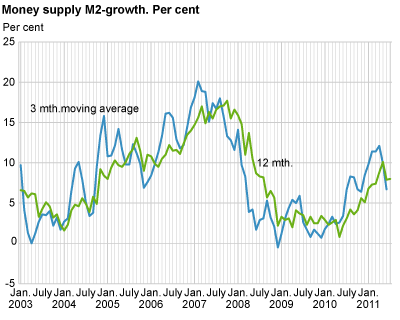Content
Published:
This is an archived release.
Increase in money supply growth
The twelve-month growth in total money supply (M2) was 8.0 per cent to end-July, up from 7.9 per cent to end-June. All the underlying sectors apart from non-financial enterprises contributed to the increase.
The total money supply amounted to NOK 1 698 billion by end-July, up from NOK 1 679 billion by end-June.
Increase in households’ money supply growth
Households’ money supply constitutes more than half of the total money supply. By end-July it accounted for NOK 918 billion, up from NOK 916 billion the previous month. The twelve-month growth in households’ money supply was 6.6 per cent to end-July, up from 5.9 per cent to end-June.
The growth in households’ money supply was lower than the growth in households’ gross domestic debt, which amounted to 7.1 per cent to end-July, according to the credit indicator C2 . For more information on the financial position of households, see the financial accounts in the national accounts .
Decrease in money supply growth for non-financial enterprises
Non-financial enterprises’ money supply amounted to NOK 543 billion at end-July, up from NOK 531 billion at end-June. The twelve-month growth decreased from 9.8 per cent to end-June, to 8.0 per cent to end-July. Non-financial enterprises’ money supply constituted about 44 per cent of their gross domestic debt measured by the credit indicator C2 at end-July.
Rise in the money supply growth for municipal government
Municipal government’s money supply amounted to NOK 79 billion at end-July, unchanged from the previous month. The twelve-month growth went up from 14.9 per cent to end-June to 15.5 per cent to end-July.
Increasing growth also for other financial enterprises
Other financial enterprises’ money supply amounted to NOK 158 billion at end-July, up from NOK 154 billion at end-June. The twelve-month growth was 13.0 per cent to end-July, up from 10.1 per cent to the previous month.
| Jan.2011 | Feb.2011 | March 2011 | April 2011 | May 2011 | June 2011 | July 2011 | |||||||||||||||||||||||||||||||||||||||||||||||||||||||||||||||||||||||||
|---|---|---|---|---|---|---|---|---|---|---|---|---|---|---|---|---|---|---|---|---|---|---|---|---|---|---|---|---|---|---|---|---|---|---|---|---|---|---|---|---|---|---|---|---|---|---|---|---|---|---|---|---|---|---|---|---|---|---|---|---|---|---|---|---|---|---|---|---|---|---|---|---|---|---|---|---|---|---|---|
| M0 - 12 mth. | 8.4 | 7.5 | 25.2 | -19.3 | -8.7 | -8.6 | 0.2 | ||||||||||||||||||||||||||||||||||||||||||||||||||||||||||||||||||||||||
| M1 - 12 mth. | 5.9 | 5.7 | 7.5 | 7.9 | 11.2 | 7.0 | 8.1 | ||||||||||||||||||||||||||||||||||||||||||||||||||||||||||||||||||||||||
| M2 - 12 mth. | 6.8 | 7.3 | 7.4 | 8.8 | 10.1 | 7.9 | 8.0 | ||||||||||||||||||||||||||||||||||||||||||||||||||||||||||||||||||||||||
| M2 - 3 mth. moving average1 | 9.8 | 11.4 | 11.4 | 12.1 | 9.9 | 6.7 | |||||||||||||||||||||||||||||||||||||||||||||||||||||||||||||||||||||||||
| M2 households - 12 mth. | 5.1 | 5.2 | 5.9 | 6.3 | 6.0 | 5.9 | 6.6 | ||||||||||||||||||||||||||||||||||||||||||||||||||||||||||||||||||||||||
| M2 non-financial enterprises - 12 mth. | 9.0 | 9.0 | 8.2 | 11.0 | 15.0 | 9.8 | 8.0 | ||||||||||||||||||||||||||||||||||||||||||||||||||||||||||||||||||||||||
| 1Annualised figure. | |||||||||||||||||||||||||||||||||||||||||||||||||||||||||||||||||||||||||||||||
Composition of money supply
The broad monetary aggregate M2 amounted to NOK 1 698 billion at end-July, of which the major part, 91.3 per cent, consisted of bank deposits. In comparison, notes and coins only accounted for 2.7 per cent. The rest of the broad monetary aggregate mainly consisted of shares in money market funds and certificates of deposits, which accounted for 5.7 and 0.3 per cent respectively.
|
The money supply (broad monetary aggregate) M2 consists of notes and coins, unrestricted bank deposits, certificates of deposit and units in money market funds owned by the money-holding sector, i.e. households, non-financial enterprises, municipalities and financial enterprises other than state lending institutions, banks and money market funds.
The base money (M0) is defined as banks’ and the money-holding sector's notes and coins and deposits in Norges Bank. Banks’ deposits in Norges Bank comprise current account (sight) deposits and fixed rate (time) deposits (F-deposits), from Norges Bank’s monthly balance sheet.
Other financial enterprises include financial enterprises other than lending institutions, banks and money market funds. |
|
Growth based on the three-month moving average is defined as growth in average money supply (seasonally-adjusted figures) in the latest three-month period in relation to the previous three-month period. The growth is adjusted for exchange rate valuation changes and statistical breaks as an annualised figure. The calculation is centred; in other words, the observation is set at the middle month of the latest three-month period. |
Tables
The statistics is published with Monetary aggregates.
Contact
-
Statistics Norway's Information Centre
E-mail: informasjon@ssb.no
tel.: (+47) 21 09 46 42

